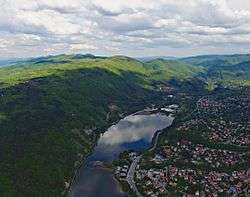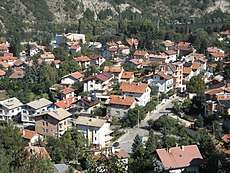Pancharevo
Pancharevo (Bulgarian: Панчарево, also transcribed as Pančarevo) is a resort village and district located on the outskirts of Sofia close to Vitosha, Lozenska and Plana mountains and occupies the southeastern part of the Capital Municipality. [1]As of 2011 the village has 3,433 inhabitants, but the district about 28,000. It is the largest region in Sofia with a total area of 364,7 km². It includes the largest artificial lake in Bulgaria Lake Pancharevo, also as Iskar Reservoir and Pasarel Reservoir, located one above the other. The districts consists of 10 villages, and Pancharevo is the municipal seat:
|
Pancharevo Панчарево | |
|---|---|
 Pancharevo and the lake, viewed from the air | |
| Country | |
| Province (Oblast) | Sofia City |
| Named as "Pancharevo" | 16th century |
| Government | |
| • Mayor | Nikolay Gyurov |
| Elevation | 700 m (2,300 ft) |
| Population (Census 2011) | |
| • Total | 3,433 |
| Time zone | UTC+2 (EET) |
| Postal Code | 1137 |
| Area code(s) | (+359) 02 992 |
| Car plates | C, CA, CB |
| Website | www.pancharevo.org, www.pancharevo-bg.com |


The district offers excellent conditions for relaxation and tourism for the citizens of the capital. The large dams are used for water sports, fishing, camping and boat trips. There are many historical sights from the Middle Ages which include the ruins of the Urvich fortress which was the site of a desperate and unsuccessful battle against the Turkish invaders in the late 14th century. There are many monasteries and chapels, some of which lie in ruins since the fall of the Second Bulgarian Empire.
The village of Pancharevo is located 12 km southeast of the city center of Sofia, along Samokovsko shosse str. It lies at 700 m. above sea level between Vitosha and Lozen mountains, and at the end of the Pancharevo gorge of Iskar River. In Pancharevo Vitoshka Bistritsa River, sloping steeply from the highest parts of the mountain, flows into Lake Pancharevo.
Pancharevo has modern suburban houses for all-year living as well as gated residence areas, and has easy access to the Sofia Ring Road, Business Park Sofia, Tsarigradsko shosse, Sofia Airport, Samokov and Borovets.
History
The Pancharevo mineral springs were probably known of the Thracians, who founded a settlement named Rilyanik, meaning abundant spring. Later, depending on their behalf period their name was transformed. In Romans time - Bathrooms Cesare / Royal /, when they were well supported by the aristocracy and the local population, and around them formed a rich imperial estate with vines. Bulgarians called them "Bathrooms Tsarevi", and the Turks - "Bandzharevi" and around them existed famous Kinan-Pashovs farm.
In Pancharevo and its environs have remained significant traces of the Roman Empire. Then it was built mineral bath which had seven pools. There are reasons to believe that both the springs in Sofia and in Pancharevo has practiced the cult of the god-physician Asklepios and the nymphs, as both places were found fragments of bareliefs of the three nymphs. Over the bath in the area of "Gradishteto" were found the remains of Roman buildings and security fortress designed to keep the barbarian invasions of the access routes from Serdica through the Iskar Gorge, in the direction of Samokov, but unfortunately no more extensive archeological studies were performed later in the area.
Pancharevo was first mentioned in the 16th-century Urvich Donation list as ПАНЧАР, ПАНЧАРЄВѠ, ПАНИЧАРЬ. Those early references allow linguists to derive its name from the noun pan(i)char, "bowl maker", itself from the noun panitsa ("bowl"). Panitsa might be a geographical term referring to a concave place.[2]
References
- "District Mayors". Sofia Municipality. Archived from the original on 2009-12-20. Retrieved 2009-12-26.
- Чолева-Димитрова, Анна М. (2002). Селищни имена от Югозападна България: Изследване. Речник (in Bulgarian). София: Пенсофт. p. 153. ISBN 9546421685. OCLC 57603720.